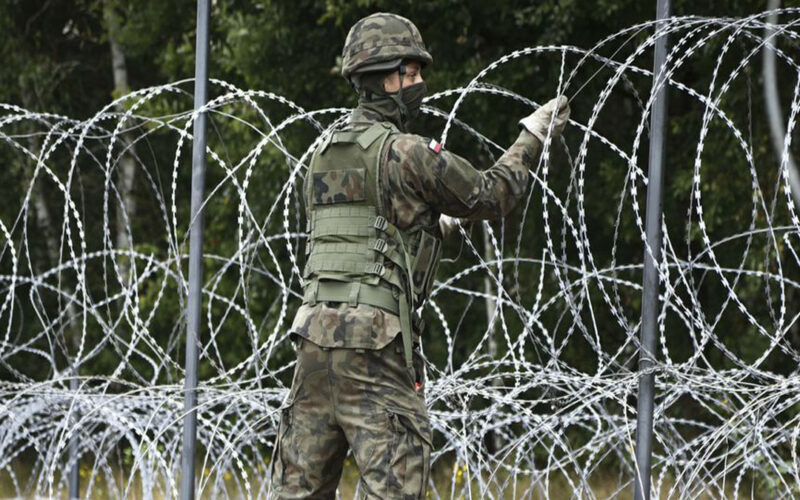Olga Gulina
After struggling with the migration crisis on European Union’s (EU) eastern borders and Belarus’ attempts at provocation, 12 EU countries have proposed fast-tracking policy changes related to migration and the policing of external borders. Poland, Latvia, and Lithuania have begun building new border structures equipped with surveillance systems, as well as monitoring their borders with Belarus.
In turn, Hungary’s Prime Minister Viktor Orbán has addressed an open letter to Ursula von der Leyen demanding reimbursement for maintaining Europe’s ‘fragile stability’ and putting ‘exemplary measures’ in place in order to protect it. This has raised the question of how long the European Union will continue to refuse to fund barbed wire and new border fences?
Over the course of the three decades following the end of the Cold War and the fall of the Berlin Wall, European countries have built fences and protective structures six times the length of the toppled Berlin Wall. In 2015, the construction of such structures on external borders cost EU countries €238 million. Hungary alone spent €1.64bn in 2015–2016 on keeping out migrants and refugees attempting to enter from the Balkans. In 2021–2022, the installation of barbed wire on the Belarusian border will cost Lithuania €152 million and Poland €353 million.
Diplomacy and opportunity – instead of barbed wire
But how effective are these walls and fences in contemporary Europe? They are only effective as symbols demonstrating that politicians are taking measures to eliminate threats – real and imagined – posed by migration flows, migrant traditions, and lifestyles that do not fit the dominant local culture. However, in the long term, this strategy will be damaging to both the EU’s economy and reputation.
In the minds of politicians and ordinary people who support such measures, defensive structures are intended to stop unwanted migration from countries where incomes are low to countries with higher living standards. They cannot, however, put an end to global inequality, solve the problem of poverty, or discourage people from seeking a better life. To put that in context, Reece Jones has shown that the GDP of countries which erect defensive structures around the perimeter of their borders is on average five times higher than the GDP of countries where migrants originate. To solve the problem of illegal migration, a long-term plan is needed, one that eliminates the motivations and reasons behind this movement.
European diplomacy has already succeeded far more than the armies of individual EU member states and their fences on the borders in curbing the threat of migration on the EU border with Belarus.
Experts proved long ago that increasing opportunities and routes of legal immigration, including regulated access to the labour market for foreign workers, is highly effective in the struggle against unauthorised migration, and that diplomacy is more effective in solving issues of security and border protection.
European diplomacy has already succeeded far more than the armies of individual EU member states and their fences on the borders in curbing the threat of migration on the EU border with Belarus. Following a meeting between the foreign ministers of Uzbekistan, Kazakhstan, Kyrgyzstan, Tajikistan and Turkmenistan, the Uzbek government has confirmed that it is willing to cooperate with the European Union and ban transit flights carrying citizens of Afghanistan, Iraq, Libya, Syria, and Yemen to Belarus. Other countries in the region have also agreed to boost cooperation on security and border protection, curb people-smuggling according to the EU-Central Asian agreement and receive financial backing from the EU.
The threat to basic rights
In 2019, the European Union Institute for Security Studies predicted that EU borders would be increasingly vulnerable because of growing migration flows and the criminalisation of cross-border movement. It warned that third countries may attempt to use mass mobility as an instrument of geopolitical influence, and called on the EU to reflect on methods of preventing hybrid attacks and provocations linked to migration, while also preserving freedom of movement within the Schengen Area.
The announced measures diverge in many ways from the declared goals. They also contravene EU humanitarian law.
Yet, as the situation on the border between the EU and Belarus has shown, no concrete scenarios, preventative measures, or mechanisms for fending off such hybrid attacks within the EU have been developed. In December 2021, the European Commission proposed measures for preventing the political manipulation of migration flows on its eastern borders for the first time. The plan aims to provide Latvia, Lithuania, and Poland with the operational support necessary for ensuring security and a humane, well-organised and dignified approach to managing migration flows that respects the fundamental human rights of those crossing through Belarus.
The announced measures diverge in many ways from the declared goals. They also contravene EU humanitarian law. In particular, the European Commission’s plan allows Latvia, Lithuania, and Poland to increase the registration period for asylum seekers to four weeks, whereas the EU Qualification Directive on international protection sets out a registration period of three to six days in such cases (10 days in situations of mass migration).
The plan also gives the migration agencies of Latvia, Lithuania, and Poland the right to accommodate asylum seekers in special centres, where only their basic rights are respected for a period of up to 16 weeks, and to limit their right of appeal. In light of the latest legislative changes introduced by the Latvian and Polish parliaments, which repeal the right to asylum in cases where the request is made immediately after crossing the border or where the border is crossed illegally, the mass movement of people on the external borders of the EU is very likely to become a destabilising force for Europe as a whole.
At present, Poland, Hungary, the Baltic nations, and other member states of the EU that share borders with non-EU countries see only one way of stemming the flow of migrants and securing their borders – putting up new walls and fences – since they have so little trust in EU diplomacy and economic leverage. But, without Europe-wide understanding and implementation of humanitarian procedures such as the right to asylum, the problem cannot be solved. The use of migration flows as an instrument of geopolitical influence over EU countries will only continue to gain momentum in the years to come.


